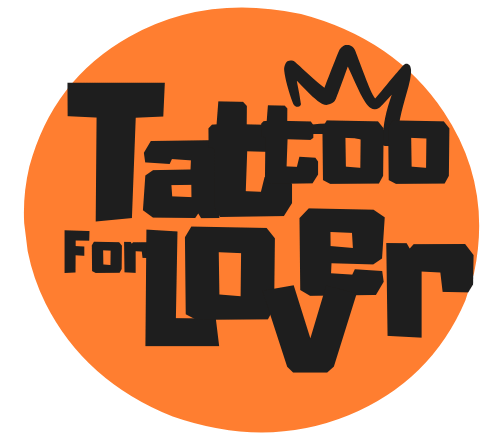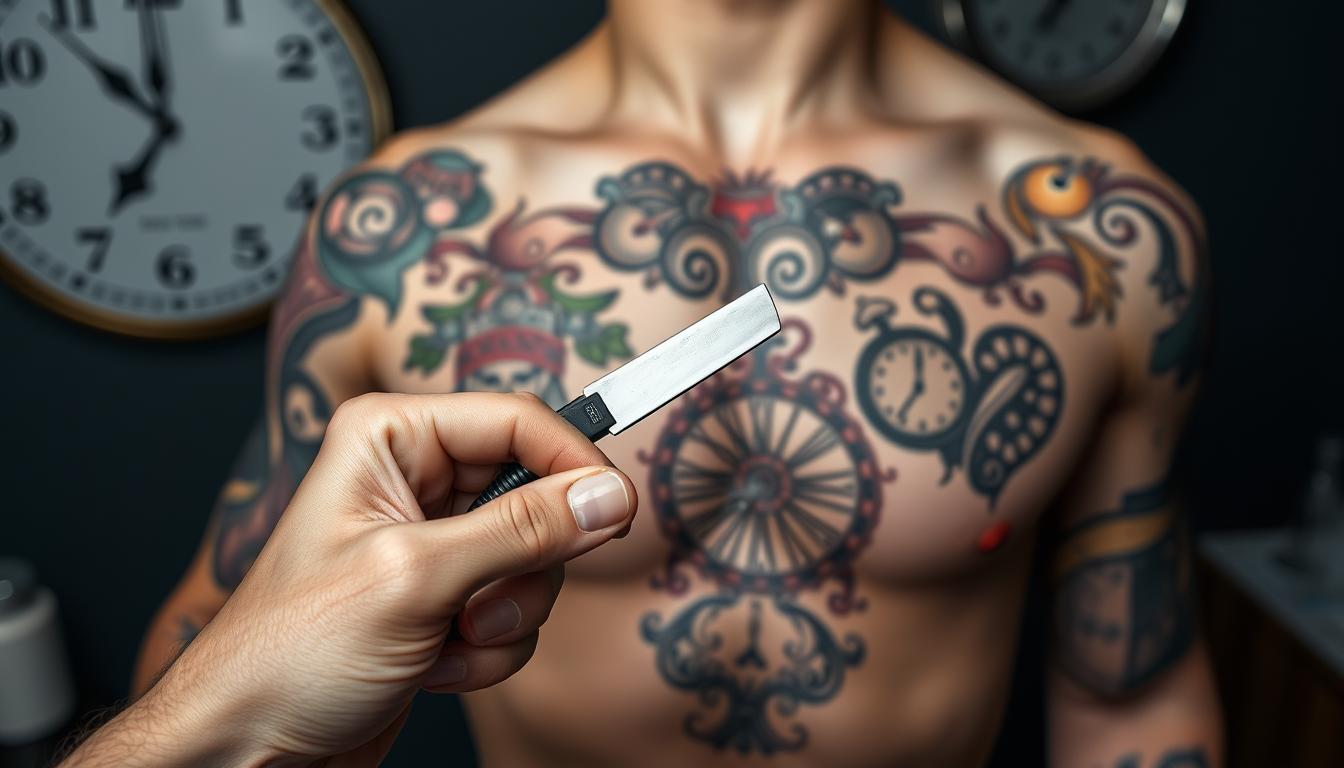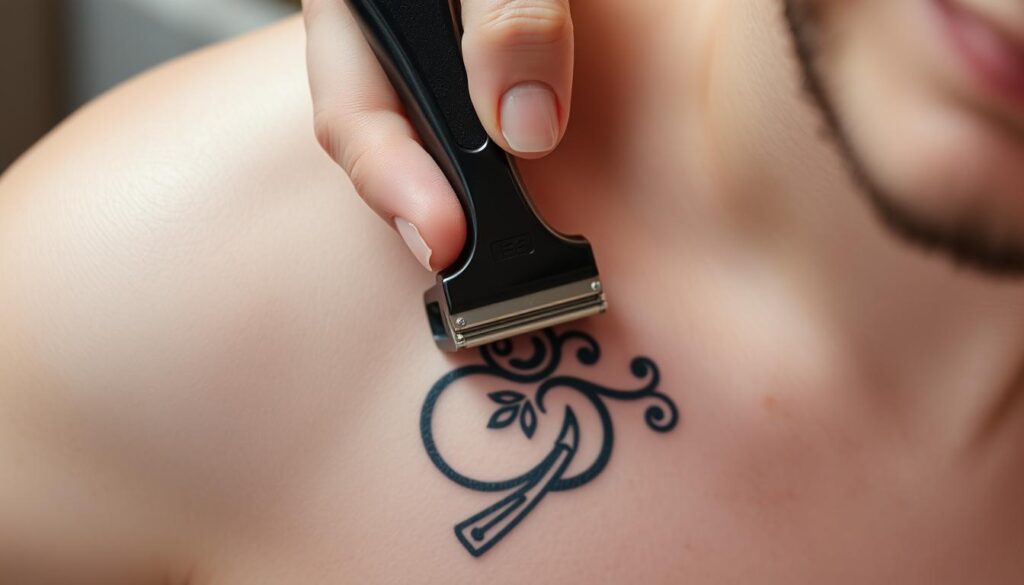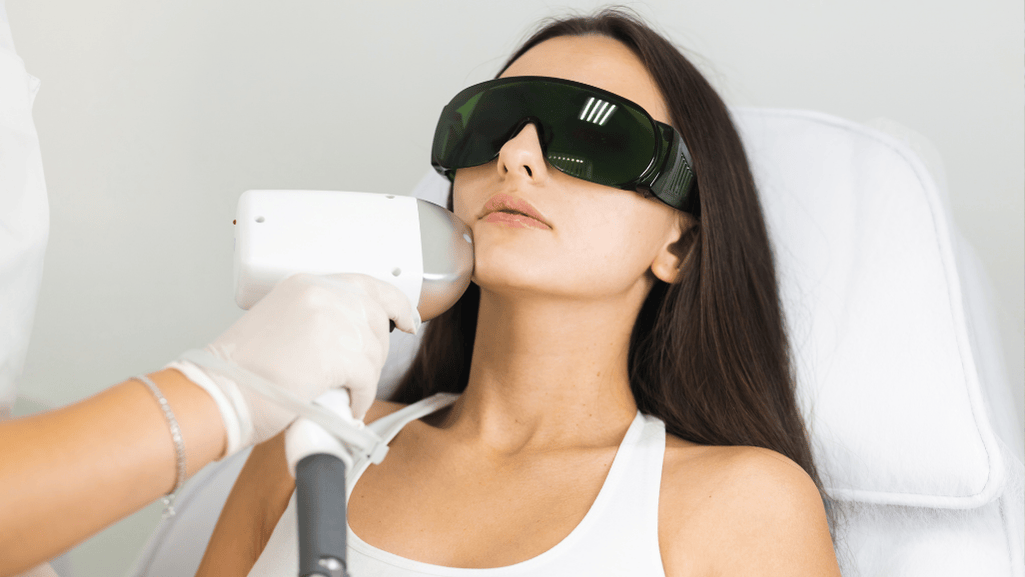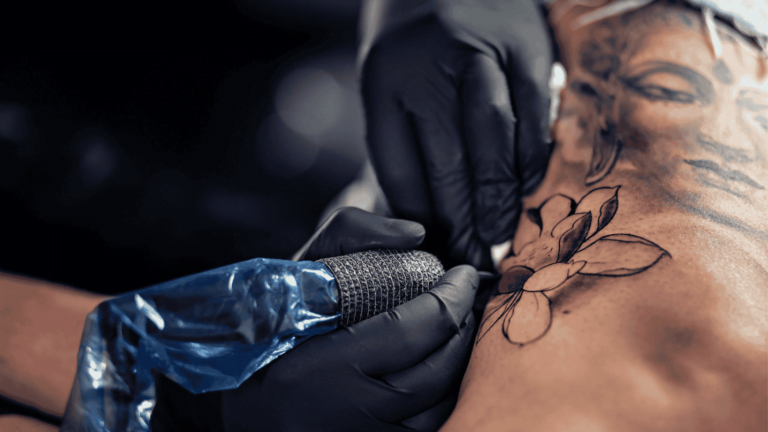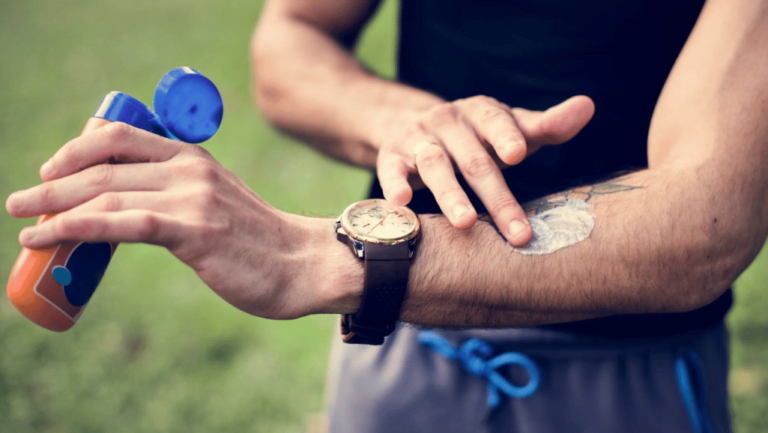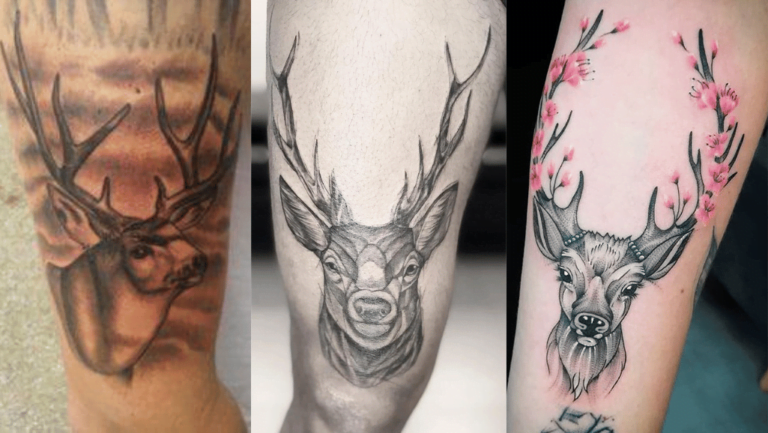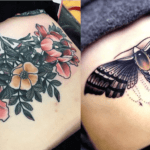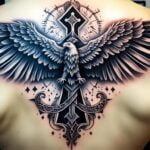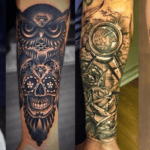Shaving your tattoo is an important part of aftercare, but it’s crucial to do it at the right time. According to experts, you should wait until your tattoo is fully healed before shaving the area. During the healing process, which typically takes two to four weeks, your tattoo goes through various stages, including redness, swelling, oozing, itching, and scabbing. Shaving too soon can damage the healing tattoo and increase the risk of infection. It’s essential to follow proper timing and techniques to protect your new ink during the shaving process. Let’s explore the details of When Can I Shave My Tattoo.
Key Takeaways
- Wait until your tattoo is fully healed, approximately two to four weeks, before shaving.
- Shaving too soon can damage the tattoo and increase the risk of infection.
- During the healing process, your tattoo may experience redness, swelling, oozing, itching, and scabbing.
- Before getting a tattoo, it’s recommended to shave the area to ensure a smooth finish and minimize the risk of infection.
- Softening the hair, using the right shaving techniques, and moisturizing the skin are crucial for safe tattoo shaving.
Shaving Before Getting a Tattoo
Before getting a tattoo, it is crucial to shave the area where the tattoo will be placed. Shaving not only ensures a smooth finish but also plays a vital role in maintaining cleanliness and preventing complications during the tattooing process. By removing hair from the area, you eliminate the risk of hair interfering with the tattoo design and ink placement. Additionally, shaving helps minimize the chances of infection, as hair can harbor bacteria that may enter the open skin during the tattooing process.
In most cases, your tattoo artist will shave the area before starting the tattooing process, even if you have shaved beforehand. This step allows them to have complete control and visibility while creating the tattoo. However, if you have sensitive skin or shaving tends to irritate your skin, it may be helpful to shave a few days prior to your tattoo appointment. This approach gives your skin some time to recover from any irritation caused by shaving, ensuring a more comfortable tattooing experience.
Importance of Shaving before Getting a Tattoo
Shaving before a tattoo holds immense importance in the overall success and quality of your tattoo. Let’s explore the key reasons why shaving is recommended before getting inked:
- Precise Tattooing: By removing hair from the tattoo area, your tattoo artist gains better visibility and control over the tattooing process, enabling them to create more accurate and detailed designs.
- Preventing Ink Interference: Hair can interfere with the tattooing process, causing the ink to deposit unevenly or blocking certain areas. Shaving ensures that the ink can penetrate the skin evenly for a more vibrant and consistent tattoo.
- Improved Hygiene: Shaving removes hair that may harbor bacteria, reducing the risk of infection during the tattooing process. Smooth and clean skin provides a safer environment for the artist to work.
Remember, when it comes to preparing for your tattoo, communication with your tattoo artist is key. They will guide you through the shaving process and provide personalized recommendations based on factors like your skin type, tattoo placement, and any pre-existing conditions.
Shaving After Getting a Tattoo
It’s crucial to wait until your tattoo is fully healed before shaving the area. Immediately after getting a tattoo, the skin is in a sensitive and vulnerable state. It may be red, swollen, and oozing liquid. As the healing process progresses, the tattooed area may become itchy and form scabs. Shaving during these initial stages can **damage** the healing tattoo, leading to poor results and potential infection. Most experts advise waiting at least two weeks, and preferably four weeks, to allow for proper healing before shaving the tattooed area.
During the healing period, it’s important to keep your tattoo clean and moisturized. Applying a gentle moisturizer can help soothe the skin and prevent dryness. Avoid using any harsh products or chemicals that can irritate or disrupt the healing process.
When the time comes to shave your tattoo, make sure to follow proper shaving practices. Softening the hair follicles is key before shaving, as it helps reduce irritation and potential damage to the tattooed area. You can accomplish this by soaking in a warm bath or shower. Additionally, gently exfoliating the skin can help remove any dead cells and dirt, resulting in a smoother shave.
During the shaving process, use a sharp, clean razor to minimize the risk of nicks and cuts. Shave in the direction of hair growth to prevent ingrown hairs and potential irritation. Applying a shaving cream or gel can help lubricate the skin and provide a smooth glide. Remember to use a light touch and avoid applying excessive pressure to the tattooed area.
Maintaining Proper Aftercare
After shaving, it’s essential to continue properly caring for your tattoo. Gently pat the area dry with a clean towel or allow it to air dry. Avoid rubbing or scratching the freshly shaved tattoo, as this can cause damage and prolong the healing process. Applying a thin layer of moisturizer can help keep the skin hydrated and protect the tattoo from dryness or irritation.
If you notice any signs of infection, such as increased redness, swelling, or pus, it’s crucial to seek medical attention immediately. Infections can occur if the tattooed area is not properly cleaned or if a contaminated razor is used during shaving. Your tattoo artist or a healthcare professional can provide appropriate treatment and guidance.
| When to Shave | Risks of Shaving Too Soon |
|---|---|
| Wait until your tattoo is fully healed, typically 2-4 weeks. | Shaving too soon can damage the healing tattoo and increase the risk of infection. |
| Softening the hair and exfoliating the skin before shaving. | Improper technique can cause irritation and disrupt the healing process. |
| Shave in the direction of hair growth. | Shaving against the grain can lead to ingrown hairs and potential damage to the tattooed area. |
| Use a sharp, clean razor and shaving cream or gel. | Using a dull or dirty razor can result in nicks, cuts, and potential infection. |
| Apply a gentle moisturizer after shaving. | Keeping the skin hydrated helps prevent dryness, itching, and irritation. |
How to Shave a Tattoo Safely
When it’s time to shave your fully healed tattoo, there are important steps to follow to ensure safe tattoo shaving and prevent shaving rash. By taking the right precautions and using proper techniques, you can maintain the integrity of your tattoo while keeping your skin irritation-free. Here are some essential shaving tips for tattoos:
1. Soften Your Hair
To prevent irritation, start by softening your hair before shaving. Soak the tattooed area in a warm bath or shower for a few minutes. This will help loosen the hair follicles and make shaving easier and less likely to cause any discomfort.
2. Exfoliate the Area
Prior to shaving, exfoliate the tattooed area gently. This will remove dead skin cells and dirt, allowing for a smoother shave. Use a gentle exfoliating scrub or a soft bristle brush to ensure you don’t damage the tattooed skin.
3. Shave in the Direction of Hair Growth
When shaving your tattoo, always go in the direction of hair growth. Shaving against the grain can cause irritation and razor burn, which can be particularly sensitive for freshly healed tattoos. Take your time and use short, gentle strokes to minimize any potential discomfort.
4. Avoid Harsh Products
Be mindful of the products you use on your tattooed skin. Avoid using scented or exfoliating shaving products, as they can cause irritation. Opt for a mild shaving cream or gel that is suitable for sensitive skin. Make sure the shaving cream does not contain any ingredients that could potentially fade or damage your tattoo.
5. Use Warm Water
When shaving your tattoo, use warm water to help open the pores and soften the hair. This will make the shaving process smoother and reduce the risk of irritation. Avoid using hot water, as it can dry out the skin and cause further irritation.
6. Apply a Moisturizer
After shaving, gently pat the tattooed area dry with a clean towel and apply a gentle moisturizer. This will help keep the skin hydrated and protect the tattoo from drying out. Look for a moisturizer that is fragrance-free and suitable for sensitive skin.
By following these safe tattoo shaving tips, you can keep your tattoo looking its best while minimizing the risk of shaving rash or other irritations. Remember to always take care of your tattoo and consult with a professional if you have any concerns or questions.
| Benefits of Safe Tattoo Shaving | Tips for Preventing Shaving Rash | Shaving Tips for Tattoos |
|---|---|---|
| 1. Reduces the risk of infection | 1. Soften the hair before shaving | 1. Shave in the direction of hair growth |
| 2. Maintains the integrity of the tattoo | 2. Use a gentle exfoliating scrub | 2. Avoid using harsh products |
| 3. Minimizes the potential for skin irritation | 3. Shave with warm water | 3. Apply a moisturizer after shaving |
Alternative Hair Removal Methods for Tattoos
If you’re concerned about using a traditional razor on your tattooed skin, there are alternative hair removal methods to consider. These methods provide a gentler approach that reduces the risk of damaging your healing tattoo. Two popular alternatives are electric razors and chemical hair removal products. Let’s explore these options and how they can help you maintain the safety and protection of your tattoo.
Electric Razor for Tattoo
An electric razor is an excellent alternative to a traditional razor when it comes to hair removal on tattooed skin. The electric razor’s design minimizes contact with the skin, reducing the risk of accidentally nicking or scratching your tattoo. It provides a smooth and gentle shave without compromising the integrity of your ink. When using an electric razor, make sure to select a model with a hypoallergenic blade and adjustable settings suited for sensitive skin.
Chemical Hair Removal for Tattoo
Chemical hair removal products offer another alternative for removing hair from tattooed areas. These products are available in various forms, such as creams, lotions, and gels, and work by dissolving the hair at the surface of the skin. Compared to traditional razors, chemical hair removal products are less traumatizing to the skin and offer a painless hair removal experience. However, it’s essential to select a product specifically formulated for sensitive skin and test it on a small patch before applying it to the tattooed area.
Using alternative hair removal methods requires caution and attention to your tattoo’s healing process. Always prioritize the safety and protection of your tattoo when exploring alternative hair removal options. Consult with your tattoo artist or dermatologist for personalized guidance and product recommendations. Remember to perform a small patch test and follow the instructions provided with the chosen hair removal method. By choosing the right alternative hair removal method, you can maintain the integrity and appearance of your tattoo while effectively managing unwanted hair.
| Method | Advantages | Disadvantages |
|---|---|---|
| Electric Razor | – Gentle and safe for tattooed skin – Minimizes the risk of damaging the tattoo – Suitable for sensitive skin | – Requires investment in a quality electric razor – May not provide as close a shave as a traditional razor |
| Chemical Hair Removal | – Less traumatizing to the skin – Painless hair removal – Works on various hair lengths | – Patch test required due to potential skin sensitivity – Limited effectiveness on thicker or coarse hair |
Conclusion
Shaving a tattoo requires patience and proper timing. It is crucial to wait until your tattoo is fully healed, which can take two to four weeks, to avoid damaging the tattoo and risking infection. Before getting a tattoo, it is recommended to shave the area to ensure a smooth finish and minimize the risk of infection.
Once the tattoo is healed, it is important to follow safe shaving practices. Soften the hair by soaking in a warm bath or shower, and exfoliate the area to remove dead skin cells. Shave gently in the direction of hair growth to minimize irritation, using a shaving cream and warm water. After shaving, apply a gentle moisturizer to keep the skin hydrated and protect the tattoo.
If you are unsure about when to start shaving your tattoo, it is best to consult with your tattoo artist or dermatologist for personalized guidance. They can provide advice based on your specific tattoo and skin type. By following these guidelines, you can maintain the integrity and appearance of your new ink while keeping your skin safe and healthy.
FAQ
When can I shave my tattoo?
What is the timeline for tattoo shaving aftercare?
What are some tattoo shaving tips?
Should I shave before getting a tattoo?
Is it safe to shave a tattoo immediately after getting it?
Are there alternative hair removal methods for tattoos?
How should I shave my tattoo to prevent irritation?
When can I start shaving my tattoo scab?
Can I use a traditional razor to shave my tattoo?
Forhad
Forhad's writing is not just about the artistry of tattoos or the latest trends in the industry; it's an exploration of the deep-rooted connections people have with their tattoos, reflecting personal narratives, cultural histories, and moments of transformation. Through a mix of in-depth features, personal narratives, and insightful analyses, he sheds light on the multifaceted nature of tattooing, revealing the emotional and cultural layers that lie beneath the surface.

